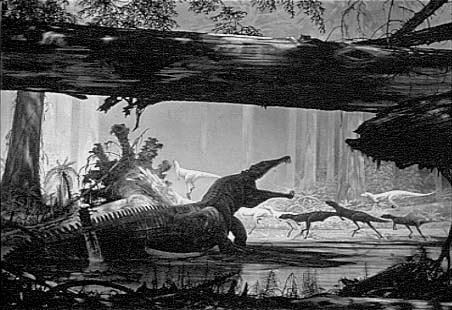February 4, 2014
Swamp Monster Skull Found in Texas
A toothy, long-nosed skull found in Texas belonged to a “swamp monster” that lived more than 200 million years ago.

A giant Pseudopalatus-grade phytosaur, “Rutiodon” lithodendrorum, length to 12 meters, startles a group of small fabrosaurs of the genus Revueltosaurus, on one of the wet floodplains of west equatorial Pangea (now, Petrified Forest National Park in Arizona), early Norian age. Illustration © Doug Henderson.
The creature is a previously unknown type of phytosaur, an extinct creature that hunted fish and other prey along the shallow edges of rivers and lakes. Dubbed Machaeroprosopus lottorum, the phytosaur probably measured about 18 feet (5 meters) long.
“They had basically the same lifestyle as the modern crocodile, by living in and around the water, eating fish, and whatever animals came to the margins of the rivers and lakes,” study researcher Bill Mueller, assistant curator of paleontology at the Museum of Texas Tech University, said in a statement.
Phytosaurs are a common find in the Cooper Canyon formation in Garza County, Texas, where the new species was discovered. This area is now dry and scrubby, but in the late Triassic, it was a conifer forest with fern underbrush and an oxbow lake where phytosaurs hunted.
Read the rest of the article here.
 About Craig Woolheater
About Craig Woolheater
Co-founder of Cryptomundo in 2005.
I have appeared in or contributed to the following TV programs, documentaries and films:
OLN's Mysterious Encounters: "Caddo Critter", Southern Fried Bigfoot, Travel Channel's Weird Travels: "Bigfoot", History Channel's MonsterQuest: "Swamp Stalker", The Wild Man of the Navidad, Destination America's Monsters and Mysteries in America: Texas Terror - Lake Worth Monster, Animal Planet's Finding Bigfoot: Return to Boggy Creek and Beast of the Bayou.
Email • Facebook • Twitter • Pinterest • Instagram •
Filed under Bigfoot Report, Cryptozoology, Evidence, Fossil Finds, Lake Monsters, New Species, Photos, River Monsters, Swamp Monsters
